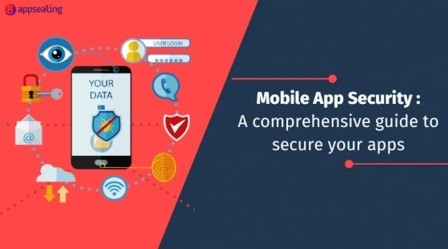TOP TIPS FOR IMPROVING MOBILE APP SECURITY: IMPORTANT ADVICE

These days, it’s impossible to function without a mobile app. Smartphone applications have made it possible to accomplish just about anything online, from paying bills to reserving a movie ticket. Businesses are overlooking important details in their haste to launch the sexiest applications on the market first. The lack of application of security principles throughout the development and deployment phases is causing problems with mobile app security. Thus, it’s critical to make sure that mobile app developments prioritize security. The top methods for improving the application security are accessible.
-
Utilizing a guarded application code:
Your mobile app’s security will be our first emphasis from the beginning. Compared to online applications, native apps are more susceptible to security breaches since their code is stored on the device after download. The most frequent error made here is to overlook the code’s security. If the code isn’t tested, it may become very vulnerable, which would make it simpler for hackers to get any type of information they need. You need encrypted code that has been thoroughly vetted for weaknesses if you want to avoid this problem.
-
Limitations gave by the platform:
It is essential to comprehend the constraints and security characteristics of the platforms for which you are creating an application. For the OS to function, you must remember a few passwords, use case scenarios, geolocation support, and encryptions. It assists with creating and releasing the ideal mobile application for particular platform selections. There are many resources accessible to help you create the ideal mobile application for an improved user experience if you want to work with the iOS system. Similarly, you may apply a few pointers to protect Android consumers’ mobile app development.
-
Protecting connections on networks:
Proper security measures should be in place on the servers that mobile apps utilize to safeguard data and thwart any illegal access. To ensure that no one outside of your company has unlawful access, API access has to be secured. You may, if desired, increase security by using a VPN or encrypted connections.
-
Ensure that all data is encrypted:
Merely encrypting the code is insufficient. Even all data transferred through mobile apps may be encrypted. Thus, even if the data is stolen, the hackers will be unable to access it. It’s all just letters with no significance until you know the key. To prevent abuse, data in workplace applications that hold sensitive information should also be encrypted. It is a recommended approach for mobile application security.
-
Make an effort to stop data leaks:
Users must consent to certain rights before installing any software, but they often ignore these requests. Businesses may be able to collect sensitive personal information about their use, which they may then utilize for their purposes. Thus, make an effort to use ethical advertising practices and make use of secure suppliers to guarantee that customer data isn’t compromised by unscrupulous merchants. Certain applications may leak user data without requesting consent from the user. Thus, ensure that once gathered, the data is safe and unstealable.
-
Reducing the storage of sensitive data:
To reduce risk, as little data storage as feasible should be used. Try not to keep any type of private user information on your servers or devices, if at all feasible. All it will do is raise the stakes. However, it is essential to employ encrypted data containers, such as containerization, if data storage is still required. Try to rely as little as possible on logs. Delete these logs automatically after a certain amount of time. This is one method for safeguarding mobile applications for later usage.
-
Create Standards for Mobile Security:
Organizations have a variety of standards that are intended to assist developers in building apps. However, security is not usually the main emphasis of these details. Most of the time, mobile apps are not mentioned. To guarantee that auto-complete is off, there are certain distinctions between iOS and Android. Occasionally, the password fields are suitably secured. Appropriate security principles and standards for the technology in use are essential.
-
Employing more advanced authentication:
Weak authentication may lead to many security vulnerabilities. Therefore, it is necessary to have a robust one, especially about passwords. Urge people to use their passwords with extreme caution. Create applications to require only stronger passwords. One method that has been shown to increase app security is two-factor authentication. The user must enter a code here, and it will be delivered to the phone number or email address they have registered. Because the newer identification methods involve biometrics like fingerprints or retinal scans, they are more secure. To find out how to improve mobile app retention, consider include it in your applications as well.
-
A more robust version of API security:
Application program Interface (API) is a major component in mobile app development. Therefore, one of the main areas of focus for mobile app security is API security. The primary routes for data, functionality, and content are APIs. Therefore, make sure your API is properly secured to protect your mobile app from any risks in the future. When developing an API, authorization, authentication, and identity are crucial security factors to take into account.
-
Full static and dynamic validation:
At this point, dynamic and static verification methods are not widely used. It didn’t make much accessible for dynamic mobile applications. That being said, it does not imply that these two security measures will not be perfectly appropriate for safe mobile development. It’s time to stop using static ways to assess mobile code during development and start using more efficient technologies. It makes sure that improper APIs aren’t misused. You can simply improve mobile app security by implementing these ten easy steps. Mobile app developers must pay careful attention to these guidelines and adhere to them when the time comes.
Conclusion
Developers take the necessary precautions to reduce risks, identify and fix vulnerabilities, and make sure the mobile app they create has hard-coded security features from the beginning.
Once you put the aforementioned tactics into practice, it will be more difficult for hackers to access your application. To safeguard your app, it’s also critical to keep up with the latest cybersecurity technologies and methods.




